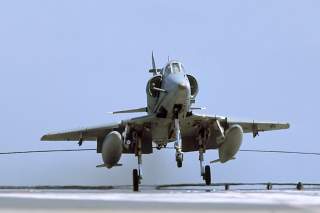The Mighty A-4 Skyhawk Was the U.S. Navy’s Best Little Bomber
Small and nimble, this warplane was a reliable Cold War attacker.
Informally called “barrels,” they caused IR guided missiles to explode a short distance away from the A-4’s tail fin rather than directly underneath, drastically increasing the aircraft’s survival.
Argentina’s employment of A-4P and A-4Q Skyhawks against the Royal Navy during the 1982 Falklands War provided a rare occasion when U.S. made aircraft were used against a U.S. ally.
These export rebuilds of the antiquated A-4B and C models endured Harrier fighters and surface-based air defenses to bomb the British task force. Their job was not made any easier by the long distances traveled through the rough South Atlantic weather, patchy intelligence and the necessity of flying at low level to stay under the Brits’ radar cover, which increased fuel consumption and reduced their staying time over targets.
The Argentine A-4s were not compatible with the infamous Exocet anti-ship missile, so they had to get close and rely on their 20-millimeter guns and unguided bombs. Nevertheless, the A-4s contributed to sinking four Royal Navy ships. The other 10 damaged British vessels would have likely joined them at the bottom of the Atlantic if more bombs had fuzed properly and gone off.
The U.S. military has long retired the A-4 and other countries such as Australia, Indonesia, Israel, New Zealand and Singapore have steadily consigned them to the scrap yard or museums. The Argentine air force somehow still keeps theirs running on an ailing budget while Brazil operates ex-Kuwaiti models from its sole aircraft carrier.
This piece first appeared in WarIsBoring here.
Image: Flickr/Creative Commons.

